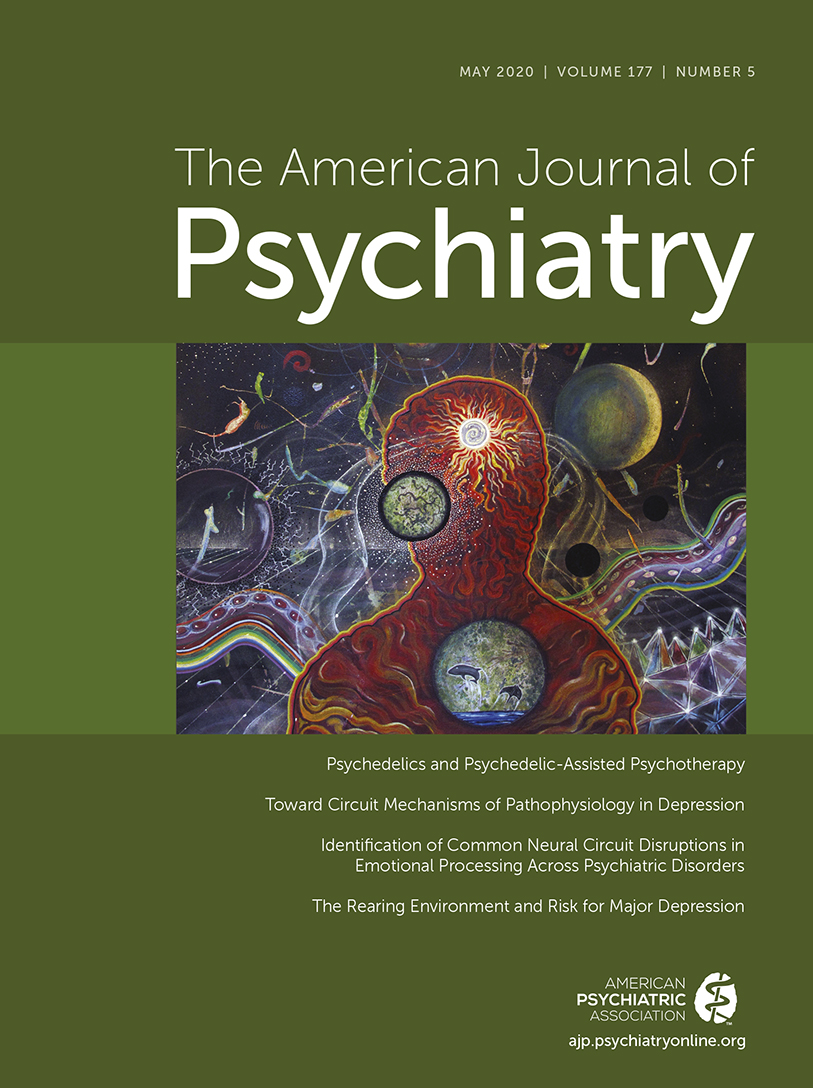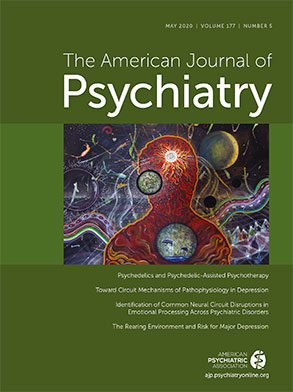Major depressive disorder has a 12-month population prevalence of 10%, which doubles over the average lifetime (
1). The clinical presentation of major depression is heterogeneous (
2), and treatment outcomes are variable. Lacking clear neurobiological substrates of depression, psychiatry traditionally explained this clinical heterogeneity in terms of clinical subtypes using features such as “atypical” and “melancholic.” The hope was to personalize treatment protocols and improve outcomes. However, these symptom-based classifications have so far failed to yield evidence-based treatment options or improve treatment outcomes in depression (
3).
Over the past 2 decades, major depressive disorder has been widely associated with disrupted affective and neurocognitive brain circuitry, revealed by modern neuroimaging and computational techniques that can generate a map of the brain’s functional and structural connections (the connectome) (
4). These connectomic and neuroimaging methods have provided an avenue to further characterize the heterogeneity in depression using biological features (biotyping), as opposed to evaluating features of a clinical presentation, raising the hopes for personalized treatment options (
5–
7).
The network-based substrates of depression have synergistically advanced circuit-based treatment techniques. Repetitive transcranial magnetic stimulation (rTMS) has been increasingly used to treat depression noninvasively by putatively stimulating large-scale, functionally interconnected brain regions (
8–
10). Most rTMS studies to date have targeted the left dorsolateral prefrontal cortex (DLPFC) with respectable response profiles in treatment-resistant depression (
11,
12). The recent combination of neuroimaging and rTMS has allowed for the differentiation of functional brain signatures, or biotypes, in depression, and post hoc analyses have associated biotypes with clinical symptom complexes (
5,
13). However, earlier biotypes of depression have been challenging to replicate (
14). Thus, whether circuit-based biotypes in depression can be deliberately modulated to improve specific depressive symptom profiles remains unclear.
Compared with conventional biotyping work that subgroups patients with similar functional network patterns and then explores therapeutic application, the authors take the inverse approach by localizing circuits and the corresponding scalp targets that relate to post-TMS improvement in depressive symptoms. The novel methodology employed in this study and the findings have potential implications for guiding personalized treatment using rTMS.
The authors used an average connectome derived from resting-state functional MRI (rsfMRI) and a network mapping method previously described by their group (
16,
17) to identify brain regions that were functionally connected with individual TMS target sites across two independent cohorts of patients with depression. The correlation between the TMS target connectivity pattern and individual symptom changes on depression scales was computed to ascertain so-called symptom-response maps. Several of these symptom-response maps appeared similar, and a clustering algorithm identified two major symptom-response patterns and their corresponding TMS target sites: anxiosomatic and dysphoric. A TMS target atlas of the DLPFC was constructed based on these symptom-response maps. At the individual level, the target atlas was used to predict an expected symptom-response ratio (i.e., an anxiosomatic-to-dysphoric ratio) based on where a patient’s brain had been stimulated. The predicted, relative to actual, symptom-response ratios were significantly correlated.
To further support the veracity of their findings, the authors rigorously tested the validity and repeatability of their findings in two independent cohorts and performed several sensitivity analyses. The authors found similar symptom-response clusters and target atlas homology for the two independent cohorts. The authors also show at the group level that their target maps predicted improvement in anxiosomatic and dysphoric symptoms that were reported in previously published rTMS trials.
Limitations and Future Directions
There was striking spatial variance in the stimulated brain region across participants, despite the use of a standardized scalp target localization technique. However, this is not surprising given the inaccuracy of the older method of localizing the DLPFC that suggested placing the coil 5 to 6 cm anterior from the motor hot spot (
18). Many recent TMS trials employ real-time MRI-guided neuronavigation or neuroimaging approximation methods to ensure target accuracy (
19,
20). In some respects, the variation in stimulation site as a result of the older approximation methods facilitated the discovery of the two unique symptom-response patterns reported by Siddiqi and colleagues.
The authors were rightly careful in generalizing their results given the study’s limitations. All cohorts were retrospectively analyzed and consisted of small sample sizes, limiting the generalizability of these retrospective data-driven findings. These results necessitate prospective replication in patients with major depressive disorder, using modern clinical trial methods. If replicated, this approach provides an important advancement in the field for localizing specific target-symptom sites for neuromodulation therapy.
Randomized clinical trials, such as the Biomarker-guided rTMS for Treatment Resistant Depression (BioTMS) trial (ClinicalTrials.gov identifier: NCT04041479), are under way to prospectively assess whether circuit-oriented biotypes can be used to predict antidepressant response to rTMS at the individual level. Similarly, other randomized controlled trials are prospectively examining how connectivity profiles with a DLPFC target site predict response to TMS in depression (ClinicalTrials.gov identifier: NCT03276793).
It is also important to highlight that these findings do not confirm that there exists a one-to-one mapping of a given symptom to a brain circuit but rather that two core symptom groups were each correlated with an average functional network pattern. Prospective studies should validate these symptom-response patterns with other depression inventories that include anxiety scales and examine how information from the Research Domain Criteria project might map to TMS target circuits.
The authors also note that these clusters result from group-based averages using a normative atlas of healthy control subjects and do not account for individual variation in functional activation and wiring, which is shown to vary between individuals in the population (
21) and in depression (
5–
7). Reassuringly, the authors performed a secondary analysis on 38 subjects who had rsfMRI sequences and demonstrated results similar to those derived from the normative connectome. Future work should attempt to replicate these functional signatures using target-seed network mapping on individual connectomes.
These findings also support the basic principles of functional segregation in the DLPFC reported by others (
22) and provide a framework for using these patterns to advance neuromodulation treatment. This functional symptom mapping method may have application to targets outside of the DLPFC. For example, this method could be elaborated further to localize divergent symptom-response target regions where neurocircuitry is anatomically proximal, such as the lateral and medial orbitofrontal cortex. Indeed, these network nodes are spatially adjacent yet appear to have divergent behavioral correlates and connectivity networks (
23,
24). This is particularly relevant as the orbitofrontal cortex is being studied as a candidate TMS target to treat depression (
25,
26), and depending on the target location, such treatment may result in variable symptom-response outcomes.
Interestingly, recent work by the same group used a lesion network mapping approach and isolated a region in the DLPFC that was functionally connected to lesioned brain regions that were associated with global depression scores (
27). This approach is based on the idea that brain lesions (e.g., ischemic infarcts) that share a common clinical symptom profile (e.g., depression) but are located in disparate brain regions may map to a common circuit within the connectome. This DLPFC region bisected the anxiosomatic and dysphoric target regions. However, the lesion mapping study did not characterize individual depressive symptoms, so future lesion network mapping studies may examine discrete symptoms in addition to global symptom scores. This could provide another approach to locate candidate TMS symptom cluster targets in psychiatric disorders. Structural imaging markers, such as anatomical covariance derived from gray matter morphometry and white matter connectivity maps, may also further refine treatment targets and provide additional information on the integrity of the cortical “hardware” subserving functional circuits (
28).
The initial findings of the present study also raised the question as to whether treatment using deep rTMS, which generates a broader induced electric field that covers deeper cortical regions, may concurrently stimulate the two sites identified by the authors. When assessing their model with the extant deep rTMS literature, they found similar improvement across both symptom domains compared with studies that used more focal coils with more specific neuroanatomical targets.
In summary, this work is a step toward the goal of precision medicine in treating depression. Compared with other current treatment modalities, rTMS is positioned to be the antidepressant therapy most likely to achieve personalization based on its ability to target discrete structures and circuits that are altered in depression. While selecting targets to treat symptom complexes provides one candidate pathway to individualize therapy, varying the stimulation dose offers another important approach for tailoring treatment. For example, the advent of theta-burst TMS, compared with conventional TMS, as well as work using a larger number of daily doses may further advance this broader goal (
19,
29). Finally, these findings need to be interpreted prudently, as it has been tempting for psychiatrists to treat depression with therapies that appear to selectively improve specific depressive and/or comorbid symptoms, despite a paucity of evidence supporting this rationale (
3). As such, these results need to be prospectively validated before clinicians start personalizing TMS treatment to individual symptoms.

